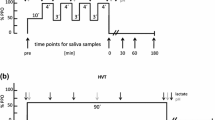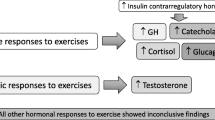Abstract
Agility ladder exercise (ALE) is a very diverse and popular activity for athletes in different disciplines. In the water polo field, ALE is used to observe the variation principle of training in non-specialized sessions and off-season sessions and for athletes with upper extremity injuries who cannot be in the pool. The present study, for the first time, investigated the acute response of growth hormones (GH), testosterone, insulin-like growth factor1 (IGF)-1, cortisol, and testosterone/cortisol (T/C) ratio following an ALE session in male water polo athletes. Using a randomized, double-blind controlled field trial, thirty male water polo athletes were divided into control (n = 15) and exercise (n = 15) groups. The exercise group performed ALE after warm-up and after that performed cool-down, while the control group just performed warm-up and cool down. Blood samples were taken 2 h before the ALE session, as well as immediately, 24, and 48 h after the ALE. Data were analyzed using repeated-measures analysis of variance (ANOVA), and p ≤ 0.05 was considered significant. The results showed that serum concentrations of GH (p = 0.001), IGF-I (p = 0.001), testosterone (p = 0.001), cortisol (p = 0.001), and T/C ratio (p = 0.02) significantly increased immediately after ALE. All changes returned to baseline within 24 h after exercise. In conclusion, anabolic hormones (GH, IGF1, and testosterone) in athletes responded appropriately to ALE. Although there was an increase in cortisol, it was low compared to the increase in testosterone. Therefore, a single session of ALE seems to have a positive physiological response in water polo athletes.



Similar content being viewed by others
REFERENCES
Pratama, N., Mintarto, E., and Kusnanik, N., The influence of ladder drills and jump rope exercise towards speed, agility, and power of limb muscle, IOSR J. Sports Phys. Educ., 2018, vol. 5, no. 1, p. 22.
Moradi, A., Sadri Damirchi, E., Narimani, M., et al., Association between physical and motor fitness with cognition in children, Medicina, 2019, vol. 55, no. 1, p. 7.
Spiteri, T., McIntyre, F., Specos, C., and Myszka, S., Cognitive training for agility: the integration between perception and action, Strength Cond. J., 2018, vol. 40, no. 1, p. 39.
Robert, S.K.N., Cheung, C.W., and Raymond, K.W.S., Effects of 6-week agility ladder drills during recess intervention on dynamic balance performance, J. Phys. Educ. Sport, 2017, vol. 17, no. 1, p. 306.
Gomez-Pinilla, F. and Hillman, C., The influence of exercise on cognitive abilities, Compr. Physiol., 2013, vol. 3, no. 1, p. 403.
Ross, J., Miller, L., and Deuster, P.A., Cognitive agility as a factor in human performance optimization, J. Spec. Oper. Med., 2018, vol. 18, no. 3, p. 86.
Cadegiani, F.A. and Kater, C.E., Hormonal aspects of overtraining syndrome: a systematic review, BMC Sports Sci. Med. Rehabil., 2017, vol. 9, no. 1, p. 14.
Azarbayjani, M.A., Dalvand, H., Fatolahi, H., et al., Responses of salivary cortisol and α-amylase to official competition, J. Hum. Sport Exercise, 2011, vol. 6, no. 2, p. 7.
Azarbayjani, M.A., Fatolahi, H., Rasaee, M.J., et al., The effect of exercise mode and intensity of sub-maximal physical activities on salivary testosterone to cortisol ratio and alpha-amylase in young active males, Int. J. Exercise Sci., 2011, vol. 4, no. 4, p. 283.
Dehghan, F., Khodaei, F., Afshar, L., et al., Effect of competition on stress salivary biomarkers in elite and amateur female adolescent inline skaters, Sci. Sports, 2019, vol. 34, no. 1. e37.
Oyola, M.G. and Handa, R.J., Hypothalamic-pituitary-adrenal and hypothalamic-pituitary-gonadal axes: sex differences in regulation of stress responsivity, Stress, 2017, vol. 20, no. 5, p. 476.
Braun, T.P. and Marks, D.L., The regulation of muscle mass by endogenous glucocorticoids, Front.Physiol., 2015, vol. 6, p. 12.
Giustina, A., Mazziotti, G., and Canalis, E., Growth hormone, insulin-like growth factors, and the skeleton, Endocr. Rev., 2008, vol. 29, no. 5, p. 535.
Velloso, C.P., Regulation of muscle mass by growth hormone and IGF-I, Br. J. Pharmacol., 2008, vol. 154, no. 3, p. 557.
Martinez-Moreno, C.G., Calderon-Vallejo, D., Harvey, S., et al., Growth hormone (GH) and gonadotropin-releasing hormone (GnRH) in the central nervous system: a potential neurological combinatory therapy? Int. J. Mol. Sci., 2018, vol. 19, no. 2, p. 375.
Gibney, J., Healy, M.L., and Sonksen, P.H., The growth hormone/insulin-like growth factor-I axis in exercise and sport, Endocr. Rev., 2007, vol. 28, no. 6, p. 603.
Varrik, E., Viru, A., Oopik, V., and Viru, M., Exercise-induced catabolic responses in various muscle fibres, Can. J. Sport Sci., 1992, vol. 17, no. 2, p. 125.
Wood, R.I. and Stanton, S.J., Testosterone and sport: current perspectives, Horm. Behav., 2012, vol. 61, no. 1, p. 147.
Luccia, T.P.B.D., Use of the testosterone/cortisol ratio variable in sports, Open Sports Sci. J., 2016, vol. 9, p. 104.
Godfrey, R.J., Madgwick, Z., and Whyte, G.P., The exercise-induced growth hormone response in athletes, Sports. Med., 2003, vol. 33, no. 8, p. 599.
Laron, Z., Insulin-like growth factor 1 (IGF-1): a growth hormone, Mol. Pathol., 2001, vol. 54, no. 5, p. 311.
Salgueiro, R.B., Peliciari-Garcia, R.A., do Carmo Buonfiglio, D., et al., Lactate activates the somatotropic axis in rats, Growth Horm. IGF Res., 2014, vol. 24, no. 6, p. 268.
Godfrey, R.J., Whyte, G.P., Buckley, J., and Quinlivan, R., The role of lactate in the exercise-induced human growth hormone response: evidence from McArdle disease, Br. J. Sports Med., 2009, vol. 43, no. 7, p. 521.
Li, W.S., Lin, H.R., and Wong, A.O., Effects of gonadotropin-releasing hormone on growth hormone secretion and gene expression in common carp pituitary, Comp. Biochem. Physiol., Part B: Biochem. Mol. Biol., 2002, vol. 132, no. 2, p. 335.
Gordon, S.E., Kraemer, W.J., Vos, N.H., et al., Effect of acid-base balance on the growth hormone response to acute high-intensity cycle exercise, J. Appl. Physiol., 1994, vol. 76, no. 2, p. 821.
Lim, C.T., Khoo, B., Normal Physiology of ACTH and GH Release in the Hypothalamus and Anterior Pituitary in Man, in: Endotext, Feingold, K.R, Anawalt, B., Boyce, A., Chrousos, G., Dungan, K., Grossman, A., et al., Eds., MDText.com: South Dartmouth (MA), 2020.
Fridlyand, L.E., Tamarina, N.A., Schally, A.V., and Philipson, L.H., Growth hormone-releasing hormone in diabetes, Front. Endocrinol., 2016, vol. 7, p. 129.
Di Blasio, A., Izzicupo, P., Tacconi, L., et al., Acute and delayed effects of high intensity interval resistance training organization on cortisol and testosterone production, J. Sports Med. Phys. Fitness, 2016, vol. 56, no. 3, p. 192.
Raastad, T., Bjoro, T., Hallen, J. Hormonal responses to high- and moderate-intensity strength exercise, Eur. J. Appl. Physiol., 2000, vol. 82, nos. 1−2, p. 121.
Boucher, P. and Plusquellec, P., Acute stress assessment from excess cortisol secretion: fundamentals and perspectives, Front. Endocrinol., 2019, vol. 10, p. 749.
Esbjornsson Liljedahl, M., Holm, I., Sylven, C., and Jansson, E., Different responses of skeletal muscle following sprint training in men and women, Eur. J. Appl. Physiol. Occup. Physiol., 1996, vol. 74, no. 4, p. 375.
Esbjornsson-Liljedahl, M., Sundberg, C.J., No-rman, B., and Jansson, E., Metabolic response in type I and type II muscle fibers during a 30-s cycle sprint in men and women, J. Appl. Physiol., 1999, vol. 87, no. 4, p. 1326.
Casanova, N., Palmeira, D.E.O.A., Pereira, A., et al., Cortisol, testosterone and mood state variation during an official female football competition, J. Sports. Med. Phys. Fitness, 2016, vol. 56, no. 6, p. 775.
Chennaoui, M., Bougard, C., Drogou, C., et al., Stress biomarkers, mood states, and sleep during a major competition: “success” and “failure” athlete’s profile of high-level swimmers, Front. Physiol., 2016, vol. 7, p. 94.
Tanner, A. and Day, S., The effects of a 4-week, intensified training, and competition period on salivary hormones, immunoglobulin A, illness symptoms, and mood state in elite synchronised swimmers, Sports (Basel), 2017, vol. 5, no. 3, p. 64.
ACKNOWLEDGMENTS
The authors would like to express their heartiest thanks to the participants whose participation made this study possible.
Funding
Islamic Azad University, Central Tehran Branch, Iran.
Author information
Authors and Affiliations
Corresponding author
Ethics declarations
CONFLICT OF INTEREST
The authors declare that they have no conflict of interest.
AUTHORS’ CONTRIBUTIONS
The present study is the result of a master’s thesis. SRA (supervisor) conceived and designed this study. MM (master student) and HF (advisor) collected the materials and performed the experiments. SRA and MM analyzed the data. MM wrote the first draft of the manuscript. SRA and HF revised the manuscript. All authors read and approved the final version of the manuscript.
Rights and permissions
About this article
Cite this article
Mirazizi, M., Rahmati-Ahmadabad, S. & Fatolahi, H. Growth Hormone, Insulin-Like Growth Factor 1, Testosterone and Cortisol Responses to a Single Bout of Agility Ladder Exercise (ALE) in Water Polo Athletes: A Randomized Controlled Field Trial. Hum Physiol 48, 732–739 (2022). https://doi.org/10.1134/S0362119722320020
Received:
Revised:
Accepted:
Published:
Issue Date:
DOI: https://doi.org/10.1134/S0362119722320020




